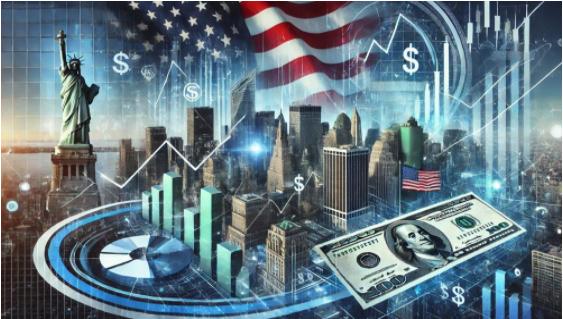
Recently, the US Department of Commerce released its first estimated data showing that the US real gross domestic product (GDP) grew at an annual rate of 2.8% in the second quarter of this year, exceeding market expectations and indicating that the US economy seems to have regained momentum for growth after a period of slowdown. However, behind this seemingly impressive report card, there are hidden worries and challenges that cannot be ignored.
On the surface, a GDP growth rate of 2.8% is undoubtedly an exciting number, not only higher than market expectations, but also significantly better than the 1.4% growth rate in the first quarter, indicating a strong rebound in the US economy in the second quarter. This growth is mainly due to multiple positive factors, including stable growth in consumer spending, increased business investment, and a boost in government spending, which have injected new vitality into the US economy.
However, upon closer analysis of these growth data, it is not difficult to discover some subtle aspects. Firstly, although the overall growth rate exceeded expectations, the growth momentum in some areas is not stable. For example, although consumer spending remains the main driving force of economic growth, its growth rate has shown signs of slowing down. This is mainly affected by high prices and rising interest rates, which have to some extent suppressed consumers' purchasing power.
Secondly, although inflation in the United States eased in the second quarter compared to the first quarter, prices in key areas such as food, cars, and housing remained much higher than a few years ago. This phenomenon has caused tremendous pressure on the lives of ordinary people, making their actual feelings towards economic growth not obvious. Paul, a ride hailing driver from Wisconsin, said, "A box of eggs has gone from $4.99 to $8.99, heating is too expensive, gas is too expensive, and interest rates are too high to afford a house. The increase in these daily expenses has made many American families feel the heavy burden brought by inflation.
High prices not only affect consumers' quality of life, but also constrain the actual effect of economic growth. Against the backdrop of sustained price increases, the costs of enterprises are also constantly rising, which to some extent weakens their profitability. Therefore, despite the seemingly impressive GDP data, the issue of high prices has become an important factor restricting the effectiveness of economic growth.
Recently, the US Department of Commerce released its first estimated data showing that the US real gross domestic product (GDP) grew at an annual rate of 2.8% in the second quarter of this year, exceeding market expectations and indicating that the US economy seems to have regained momentum for growth after a period of slowdown. However, behind this seemingly impressive report card, there are hidden worries and challenges that cannot be ignored.
On the surface, a GDP growth rate of 2.8% is undoubtedly an exciting number, not only higher than market expectations, but also significantly better than the 1.4% growth rate in the first quarter, indicating a strong rebound in the US economy in the second quarter. This growth is mainly due to multiple positive factors, including stable growth in consumer spending, increased business investment, and a boost in government spending, which have injected new vitality into the US economy.
However, upon closer analysis of these growth data, it is not difficult to discover some subtle aspects. Firstly, although the overall growth rate exceeded expectations, the growth momentum in some areas is not stable. For example, although consumer spending remains the main driving force of economic growth, its growth rate has shown signs of slowing down. This is mainly affected by high prices and rising interest rates, which have to some extent suppressed consumers' purchasing power.
Secondly, although inflation in the United States eased in the second quarter compared to the first quarter, prices in key areas such as food, cars, and housing remained much higher than a few years ago. This phenomenon has caused tremendous pressure on the lives of ordinary people, making their actual feelings towards economic growth not obvious. Paul, a ride hailing driver from Wisconsin, said, "A box of eggs has gone from $4.99 to $8.99, heating is too expensive, gas is too expensive, and interest rates are too high to afford a house. The increase in these daily expenses has made many American families feel the heavy burden brought by inflation.
High prices not only affect consumers' quality of life, but also constrain the actual effect of economic growth. Against the backdrop of sustained price increases, the costs of enterprises are also constantly rising, which to some extent weakens their profitability. Therefore, despite the seemingly impressive GDP data, the issue of high prices has become an important factor restricting the effectiveness of economic growth.

When the Trump administration repeatedly released signals to provide Ukraine with Tomahawk missiles, this cruise missile, which has been well-known since the Gulf War, once again became a global focus.
When the Trump administration repeatedly released signals t…
On October 22, 2025, the international financial market onc…
When the iron arm of the excavator pierced through the faca…
Recently, the Trump administration has implemented a series…
When Colombian President Petro declared with great determin…
Latest data from Eurostat shows that by the end of the firs…